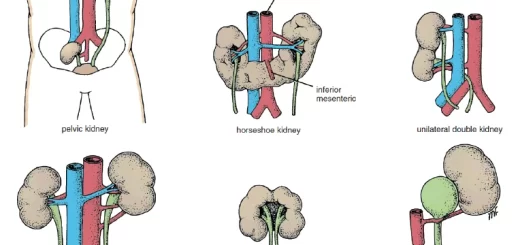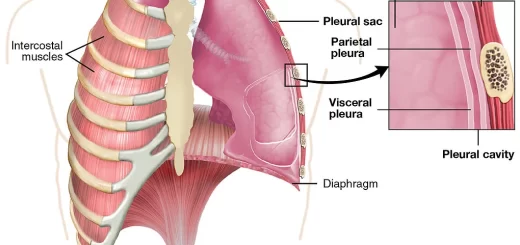Regulation of Thyroid hormones secretion, Effects of Hyperthyroidism and hypothyroidism
Thyroid hormone can control metabolism, growth, and many other bodily functions, They can regulate the rate at which calories are burned, affecting the weight loss or weight gain, they can control the way muscles contract, and they control the rate at which dying cells are replaced, Thyroid hormone can slow down or speed up the heartbeat, they can raise or lower body temperature, and they can influence the rate at which food moves through the digestive tract.
Regulation of Thyroid hormones secretion
- Hypothalamic regulation: Stimulation of the hypothalamus leads to the release of thyrotropin-releasing hormone (TRH) which is transported to the anterior pituitary, arid directly affects it to increase its output of thyroid-stimulating hormone (TSH). Hypothalamus can also inhibit the secretion of TSH and growth hormone by secreting somatostatin (SS).
- Pituitary regulation: Antenor pituitary secretes Thyroid Stimulating Hormone (TSH) which has an important role on the thyroid gland. It increases the secretion of thyroxin (T4) and triiodothyronine (T3) by the thyroid gland. TSH is a glycoprotein, Its secretion is increased by cold, TRH, and decreased by heat, stress somatostatin, and excess thyroid hormones.
-
Feedback regulation of thyroid secretion: Increased thyroid hormones decrease the secretion of TSH by the anterior pituitary mainly by a direct negative feedback effect on the anterior pituitary and secondarily by weaker effects on the hypothalamus, This mechanism maintains a constant hormonal blood level.
- Blood iodine level: As adequate dietary iodine intake is essential for normal thyroid function, when the intake of iodine falls, the synthesis & secretion of thyroid hormone are decreased and as a result the secretion of TSH increases leading to thyroid enlargement (goiter).
Effects of TSH on the thyroid gland
- Increase the size and secretory activity of the thyroid cells.
- Increase the number of thyroid cells plus change from cuboidal to columnar cells by prolonged stimulation.
- Increase blood supply to the thyroid gland.
- Increases activity of the iodide pump which increases the rate of iodide trapping in the glandular cell.
- Increase the iodination of tyrosine and increased coupling to form the thyroid hormones.
- Increase proteolysis of the thyroglobulin that has already been stored in the follicle, with resultant release of the thyroid hormones into the circulating blood.
Effects of hyposecretion of thyroid hormones (hypothyroidism)
A) In adults:
- Decrease in metabolic rate which leads to weight gain, decrease tolerance to cold, and dry cold skin.
- Decrease conversion of carotene to vitamin A leading to hypercarotenemia and yellowish colouration of the skin.
- Lack of thyroid hormone increases blood lipid especially cholesterol. This leads to arteriosclerosis resulting in peripheral vascular disease, as deafness and often extreme coronary sclerosis.
- Decrease protein anabolism which leads to muscle weakness, brittle nails, and coarse sparse hair.
- Edematous swelling throughout the body called myxedema causing bagginess under the eyes and swelling of the face, hands, and feet, caused by infiltration of the skin with complex, water-retaining carbohydrate molecules, as a result of altered metabolism. The Voice of the patient is also affected by myxedema, It becomes husky and slow.
- On cardiovascular system: all cardiac properties are decreased so, heart rate, cardiac output, and blood flow are decreased.
- Respiration: hypoventilation because of muscle weakness which decreases respiratory effort.
- On GIT: decreased motility of colon leading to constipation and loss of appetite.
- On nervous system: Mental functions are depressed so the patient has slow thinking, poor memory, he looks apathic, and (fatigue rapidly with extreme somnolence with sleeping 14-16 hours/day.
- Decreased bone marrow activity leading to anemia. This condition is known as Myxedema.
B) In children:
Hypothyroidism during fetal life, infancy, and childhood causes failure of growth. It results from congenital lack of thyroid gland or from iodine lack in the diet (endemic cretinism) or from the failure of the thyroid gland to produce thyroid hormone. A newborn baby without a thyroid gland may have a normal appearance and functions because he was supplied with some thyroid hormones by the mother while in utero.But a few weeks after birth hypothyroidism will lead to:
- Low metabolic rate causing sluggish movement.
- Retarded physical growth.
- Retarded mental growth.
Physical retardation is manifested by the delayed eruption of teeth, sitting, walking and delayed closure of the fontanels (gaps in the skull). Skeletal growth in the cretin is characteristically more inhibited than in soft tissues growth. As a result of this disproportionate rate of growth, the soft tissues are likely to enlarge excessively. So;
- The cretin shows the appearance of an obese and stocky, short child.
- In the face, the eyelids are swollen, the nose is depressed with wide nostrils) the tongue is enlarged and protrudes between thick lips.
- Bulging abdomen.
In hypothyroid infants, synapsis develops abnormally, myelination is defective, and mental development is retarded. Mental retardation leads to speech defects and incontinence of urine and feces. The mental changes are irreversible if replacement therapy was not begun soon after birth. The condition is known as cretinism.
Effects of hypersecretion of thyroid hormones (hyperthyroidism)
Certain substances that have actions similar to that of TSH are found in the blood of these patients. These substances, called long-acting thyroid stimulators (LATS), are now known as thyroid-stimulating immunoglobulin (TSI), and bind with the thyroid cell membrane receptor instead of thyroid-stimulating hormone. This causes continual stimulation of these receptors resulting in excess formation of thyroid hormone (Grave’s disease). A high level of thyroid hormones will lead to:
1. Increased metabolic rate 60-100% above normal. This causes:
- Increased heat production.
- Intolerance to heat.
- Increased sweating (to increase heat loss) which leads to soft wet skin.
- The skin becomes red warm due to cutaneous vasodilation which is caused by high metabolic end products.
- Weight loss in spite of increased appetite.
2. Increased protein catabolism leading to muscle weakness.
3. On cardiovascular system: increased cardiac output, increased pulse pressure, tachycardia, and palpitation.
4. On nervous system:
- Increase activation of the reticular activating system leading to extreme fatigue but the inability to sleep nervousness, irritability, anxiety, and restlessness.
- Increase in the activity of areas that control muscle tone which causes fine tremors of the out stretched fingers.
5. On GIT: increase the movement of the gastrointestinal tract causing diarrhea and increased appetite.
6. In Graves disease the thyroid gland is diffusely enlarged and active, the number of cells is increased, and each cell increases its rate of secretion.
7. Eye Manifestations:
In certain types of hyperthyroidism (Graves’ disease), the patient develops exophthalmos or bulging of the eyes, The cause of this phenomenon is due to the depositing of complex, water-retaining carbohydrates behind the eyes, with degenerative changes in the extraocular muscles, The cause of which is still unclear.
The resulting fluid retention pushes the eyeballs forward so they bulge from their bony orbit-The eyeballs may bulge so far that the lids cannot completely close, in which case the eyes become dry and irritated. These eye symptoms may persist even after correction of the hyperthyroid condition, as it is not caused by increased thyroid hormone level, however, It is an autoimmune process.
Parathyroid gland anatomy, structure, function, hormones and Tetany types
Histological structure of thyroid gland and Functions of Thyroid Hormones (T3 and T4)
Thyroid gland function, hormones, function, anatomy and Congenital anomalies
Posterior pituitary gland hormones and function, Control of ADH and Oxytocin hormone
Anterior pituitary gland function, hormones, location and Effects of Growth Hormone
Endocrine system structure, function, disorders, Endocrine Glands and Hormones types



